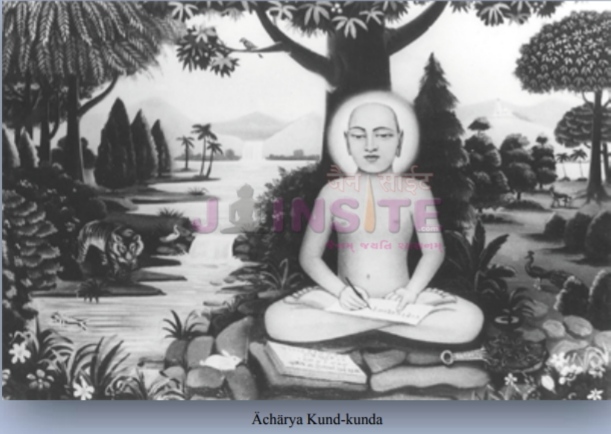Ächärya Kunda-kunda
मंगलं भगवान वीरो, मंगलं गौतमो गणि |
मंगलं कुन्दकुन्दायाेंं , जैन धमोंंस्तु मंगलं |
mangalam bhagaväna viro,
mangalam gautamo gani |
mangalam kundakundäryo,
jaina dharmostu mangalam ||
Bhagawän Mahävir is auspicious;
Ganadhar Gautam Swämi is auspicious;
Ächärya Kunda-kunda is auspicious;
Jain religion is auspicious.
The great spiritual saint Kunda-Kundächärya occupies the highest place in the tradition of Jain Ächä He is remembered immediately after Bhagawän Mahävir and the preceptor Gautam Ganadhar as an auspicious blessing. Everyday, Digambar Jains recite the couplet with the three adorable reverentially before starting the study of religious texts. Jain monks feel honored in being included in the tradition of Kunda-Kundächärya.
In the southern state of Tamilnadu in India, atop a hill known as Ponnur Malai, on a large stone under a certain Champä tree, pilgrims may stumble upon an engraved pair of footprints (Charan). These
footprints are symbolic of a thinker who, nearly two thousand years ago, composed some of the most influential philosophical books. Generations of scholars can remember the exact day of their first encounter with this thinker’s spiritual masterpiece, the Samay-sär.
Ächärya Kunda-kunda is one of the most famous Jain Ächäryas. He is a great organizer of the highly complex concepts of Jain philosophy. He is the celebrated author of five renowned books:
• Samay-sär (Treatise on the True Self)
• Pravachan-sär (Treatise of Preaching)
• Niyama-sär (Treatise on Rules of Conduct)
• Panchästikäya (Treatise on Five Universal Substances)
• Ashta-pähud (Eight Steps), a collection of eight texts
All his works are written in an ancient dialect known as Saurseni Präkrit which is similar to Ardha- mägadhi Präkrit. The organizing of Jain ideas into certain relationships and structures, taken for granted in recent centuries, was a product of his genius. So extraordinary was this idea that many other books written in this style by his pupils and other Jain scholars are popularly ascribed to him. In the Digambar tradition, he is praised immediately after Lord Mahävir and the preceptor Gautam-swämi in the auspicious blessing(Mangalächaran) prayer. Jains of the Digambar tradition dub their tradition Kunda-kunda Anvaya (the order of Kunda-kunda). However, scholars of all sects study his books with deep veneration.
He was born around the beginning of the first century AD in Southern India in a place named Konda- konda. Kunda-kunda belonged to an ancient order called the Nandi Sangha, wherein most monks assumed names ending in “Nandi”. His official name after becoming a Jain monk was Padma-nandi, but he is better known by the place of his origin. Kunda-kunda mentions that he was a descendant of Bhadrabähu- swämi, the last Shruta Kevali Ächärya who possessed complete knowledge of the twelve Anga Ägams including the 14 Purvas.
Punya Shrävak Kathä Kosha mentions that in his previous life Kunda-kunda was a cow herder who had found and preserved ancient texts and was blessed by a wandering monk. Ächärya Kunda Kunda’s intense learning and moral character attracted royal disciples such as King Shiva Kumar. The story of Kunda- kunda is also surrounded by a legend – it is even said that he could walk on air!

Acharya Kund-kunda


